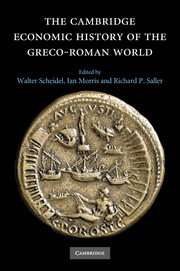Book contents
- Frontmatter
- 1 Introduction
- Part I Determinants of Economic Performance
- 2 Ecology
- 3 Demography
- 4 Household and Gender
- 5 Law and Economic Institutions
- 6 Technology
- Part II Early Mediterranean Economies and the Near East
- Part III Classical Greece
- Part IV The Hellenistic States
- Part V Early Italy and the Roman Republic
- Part VI The Early Roman Empire
- Part VII Regional Development in the Roman Empire
- Part VIII Epilogue
- Bibliography
- Index
- Map 1.1 The Mediterranean basin"
- Map 10.1 Greek and Phoenician trade in the period of the Persian Wars"
- Map 11.1 The Achaemenid empire"
- Map 12.1 Greece and Asia Minor"
- Map 15.1 The Seleucid empire"
- Map 16.1 Greco-Roman Egypt"
- Map 20.1 The Roman empire at the accession of Vespasian"
- References
3 - Demography
from Part I - Determinants of Economic Performance
Published online by Cambridge University Press: 28 March 2008
- Frontmatter
- 1 Introduction
- Part I Determinants of Economic Performance
- 2 Ecology
- 3 Demography
- 4 Household and Gender
- 5 Law and Economic Institutions
- 6 Technology
- Part II Early Mediterranean Economies and the Near East
- Part III Classical Greece
- Part IV The Hellenistic States
- Part V Early Italy and the Roman Republic
- Part VI The Early Roman Empire
- Part VII Regional Development in the Roman Empire
- Part VIII Epilogue
- Bibliography
- Index
- Map 1.1 The Mediterranean basin"
- Map 10.1 Greek and Phoenician trade in the period of the Persian Wars"
- Map 11.1 The Achaemenid empire"
- Map 12.1 Greece and Asia Minor"
- Map 15.1 The Seleucid empire"
- Map 16.1 Greco-Roman Egypt"
- Map 20.1 The Roman empire at the accession of Vespasian"
- References
Summary
Demographic conditions are a major determinant of economic performance. In the following, I focus on the relationship between demographic structures and macro-economic features. The economics of household and gender are discussed in the next chapter. After a brief outline of the fundamental demographic characteristics of the Greco-Roman world (i–ii), I present a theoretical model of the interdependence of economic and demographic development, and explore its principal variables in the context of ancient Mediterranean economies (iii–viii). This introductory survey is meant to provide a conceptual framework for the more specific discussions in Chapters 7 to 28, and more generally seeks to contextualize the study of Greek and Roman economic and demographic history within the wider ambit of historical demography and population theory. While many of the issues raised in the following sections cannot be satisfactorily addressed on the basis of ancient evidence, they are nevertheless essential to our understanding of ancient economies.
life expectancy and its correlates
Mortality and morbidity
In recent years, researchers have established a broad consensus regarding the basic structure of ancient populations. Continuing controversies are now largely confined to particular interpretations of the evidence, which are of limited relevance here. The populations of the ancient world were characterized by a regime of high fertility and mortality. While mean life expectancy at birth is conventionally put in a range from about twenty to thirty years, the actual age structures of ancient populations (and thus age-specific survival rates) are generally unknown. Age records from some 300 census returns filed in Roman Egypt during the first three centuries ad have been used to reconstruct female and male age distributions that are broadly consistent with model life tables suggesting a mean life expectancy at birth of twenty-two to twenty-five years.
Keywords
- Type
- Chapter
- Information
- The Cambridge Economic History of the Greco-Roman World , pp. 38 - 86Publisher: Cambridge University PressPrint publication year: 2007
References
- 97
- Cited by



